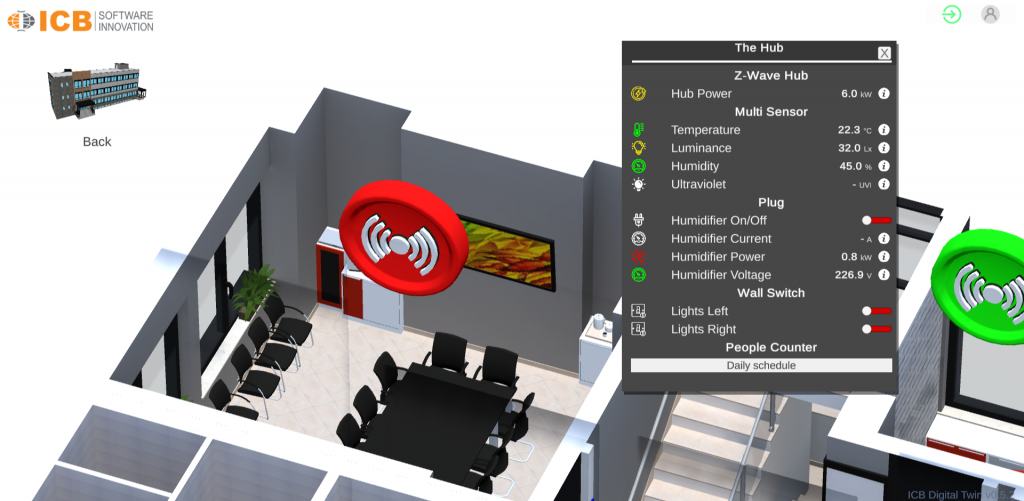Digital Twin ICB Building Showcase

There’s a widespread joke that the true driver for the digital transformation of many companies in 2020 was COVID. Since the lockdowns worldwide happened many companies started to experience what the digital enterprise means.
ICB has been long ready for such shift and it took us one day to get our entire infrastructure ready for work-from-home. However we were left with a beautiful lonely building for some weeks. And as we really love our home we decided to make sure we can look at it while having our morning syncs and drinking coffee 🙂
Although this was a benefit of our office’s digital twin visualization the real drivers were a bit different.

Automation and optimization are the real drivers for digital twins
We wanted to know key metrics like:
- What is the humidity, temperature and air quality within and around the office
- How many people are working from the office each day
- How much power do we consume
- How is the AC system performing each day
Ultimately we are aiming at a greener building, less costs for electricity water and maintenance activities, and understanding other relevant metrics for better balance at work and building efficiency.
Furthermore, we wanted to automate our daily activities and not think about routine tasks. You might say we wanted to apply robotic process automation but powered by solid artificial intelligence. For example:
- We wanted to make sure that rooms are all prepped before meetings. Especially the larger rooms tend to get smelly or stuffy when more people are in the room (no matter how shiny, new and clean your office is). So we thought of scenarios – 10 minutes before the meeting check the temperature and quality of the air > if the outside air’s quality is good open the window for 5 minutes > if the temperature after opening the window is low turn-on the AC.
- We also wanted to use our electrical shades automatically, not manually, so we also had to consider the appropriate sensors for temperature and light within the rooms to make them close and open automatically.

Things we achieved
Connected sensors and systems:
- The air station on the roof give us information about:
- Air quality
- Temperature
- Humidity
- Pressure
- Inside the rooms we have various sensors, but to put them all together they give us information about:
- Temperature
- Humidity
- Ambient light
- Garage Door Open/Close Automation
Here are some of the features:
- We are applying Machine Learning for free parking space detection through standard RGB CCTV cameras’ video stream. We are using our standard CCTV cameras to see which of the parking spaces are available. When the system recognizes that the parking spaces are taken if automatically fills-then-in with a 3D modelled car so users would know which ones are taken. Here is how it looks:

- We modeled in great detail the building. Even the tiles on each floor is exactly how it looks in reality. Check-out how the chairs are different in some of the rooms. Our 3D modelers took special attention to the details. Check-out how detailed the controls of our ship simulator room are. You can see all the buttons!

- In addition to modeling the building, we wanted to visualize how it really looks so we grabbed our 360 camera and made a walk-through.

- We keep weather station data and visualize it for 7 days. We even put some minimums and maximums for each parameter to monitor if they are within the desired range.
- The same goes for parameters within the building. We are actually automatically controlling the humidity and lights in our conference rooms. Whenever it gets too dark we turn the lights on. If the humidity gets too low we turn-on the humidifier.

- The system is also keeping track of our server room’s temperature and humidity. We’ve integrated the sensor data with tracking critical levels. If the levels are lower or higher than the critical levels our colleagues, administering the server room are receiving notifications (email and sms).

- Each of the conference rooms are integrated with the corporate calendars and have color coding, depending on how many people are invited for the particular meeting and how much the room can hold.
- Parts of the system is locked and controlled only by authorized users. For example opening the doors of the parking, turning on/off the humidifier and lights in the rooms is not available without a password and username.
But the rest of the features are available at https://dtw.icb.bg/
How did we achieve it?
Architectural drawings, 3D modelling and animation was done via custom modelling by our modelling experts.
The 360 degree functionality was especially patched with a 360 degree camera.
All of the sensor and automation data is running through our proprietary software engine for Internet of Things. It allows us to add different types of sensors and have scenarios defined easily.
The rest of the system relies on:
- .NET Core
- Microservices
- Configuration is saved in MS SQL
- The historical data we keep in InfluxDB
- .NET Core RESTful APIs, containerized in docker
- Unity is used for the digital twin itself, which is being exported in web assembly
- React for front-end configuration
- FFMPEG is used for the video streaming

What’s next
We are now working on:
- Integration with our Central Air Control System
- Automating the shades with the internal ambient light sensors
- Starting to count people going in and out and checking their temperature as they come into the office
- Developing artificial intelligence scenarios, which will enable electricity and water usage to drop
Got you interested? Get in touch for your building’s digital twin.
sales@icb.bg
Tags In
Categories
- EVENTS (5)
- News (44)
- R&D (3)
- Success stories (21)
- Uncategorized (7)
